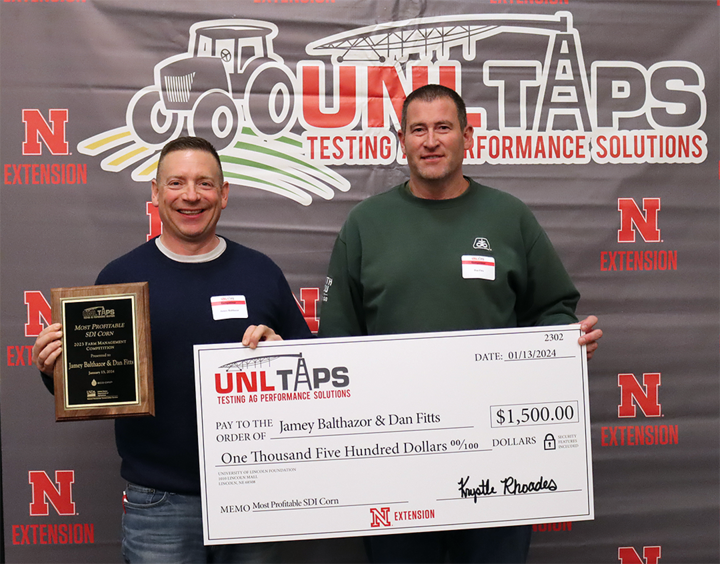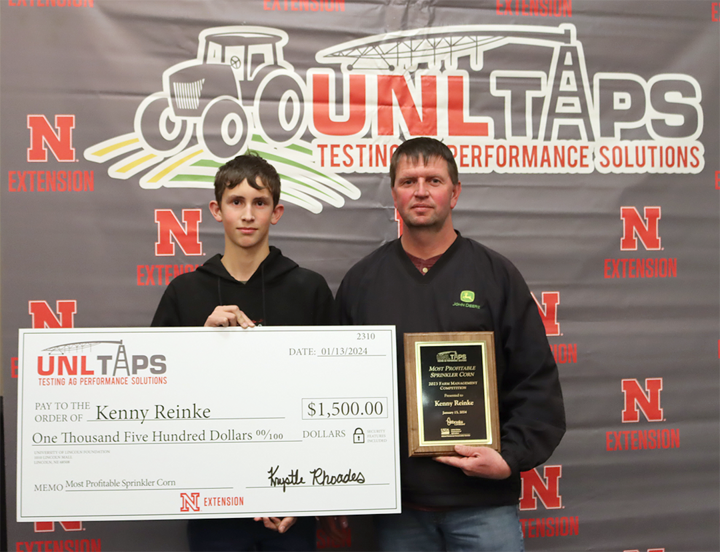The Testing Ag Performance Solutions (TAPS) awards banquet held on Jan. 13 was the culmination event for the program’s seventh year of farm management competitions. The TAPS program was created by University of Nebraska educators and specialists as an innovative way of connecting producers to industry professionals and offering a way of testing out new, advancing technologies through farm management competitions facilitated at the West Central Research, Extension and Education Center in North Platte, Nebraska.
Despite the winter weather, the event was a night of interaction and celebration of the 2023 competitions, which included popcorn, sorghum, subsurface drip irrigated (SDI) corn and sprinkler irrigated corn. The participants in each competition made their own individual input decisions for their plots located in the same field as fellow competitors. These decisions differed for each competition including crop insurance, hybrid and seeding rate, nitrogen timing and amount, irrigation timing and amount, insecticide, fungicide, and marketing of their crop.
For the first time in the seven-year history of the program, the competition fields located in North Platte were affected by hail, which ultimately resulted in changes to the remaining management decisions and the final results.
Awards were given in each competition for greatest grain yield, highest input use efficiency and most profitable. These designations came with a cash prize, along with a plaque, oversized check and personalized TAPS apparel item.
Sorghum
The sorghum contest, in its sixth year, included both a dryland and irrigated portion, which were relocated this year to the Henry J. Stumpf International Wheat Center near Grant, Nebraska. There were 18 teams that competed. The team that included Brandon Rimpley of Orleans, Nebraska, and Ron Robison of Alma, Nebraska, earned all three of the top honors for yield, efficiency and profitability.
Irrigated Popcorn
The program’s newest competition — the irrigated popcorn competition — had 13 teams compete. The winners in the popcorn competition included:
- Roger Lansman of Ord, Nebraska, for the greatest yield award.
- Nate Freitag of the Byron, Nebraska area took home the highest input use efficiency accolade.
- AK Acres from Imperial, Nebraska won the award for most profitable.
SDI Corn
In the fifth year of the SDI corn competition, 16 teams competed. The award winners in the SDI corn competition included:
- Lorn Dizmang of Dizmang Ag in Moorefield, Nebraska for the greatest yield award.
- The Rattlesnake Boys from Wood River, Nebraska took home the highest input use efficiency accolade. The team consisted of Kevin and Amy Harsch, Jay Johnson and Jeremy Gewecke.
- Jamey Balthazor and Dan Fitts from Scottsbluff and Gering, Nebraska won the award for most profitable.

Sprinkler Corn
The seventh year of the sprinkler corn competition had 38 teams participate.
- The greatest grain yield award was won by Tom Carpenter of Bartley, Nebraska.
- The Perkins Group team from the Grant, Nebraska area earned the highest input use efficiency award. The team was made up of Brent Gloy, Bruce Young, Curt Richmond, Jeremy Hagan, Nick Turner, Pat McGreer, Shawn Turner, Ted Tietjen and Troy Kemling.
- Kenny Reinke of Neligh, Nebraska won the award for most profitable.

The last award presented was the outstanding TAPS advocate, which honors an organization, person or business that went above and beyond in supporting the UNL-TAPS program. This year, the award recipient was Tracy Zink of Indianola, Nebraska. Since the moment Zink heard about the TAPS program, she has not only chosen to participate, but also to share what she has learned, invited others to join the program and promoted TAPS across many avenues that she engages in across the state and nationally.
The full 2023 TAPS Competition report can be found on the TAPS site.
The TAPS program would like to thank all the sponsors, supporters and participants for being a part of and making the program a continued success.
The 2024 TAPS competitions are already being planned. Anyone interested in the program can email Krystle Rhoades, TAPS program manager.
Founded in 2017, the Testing Ag Performance Solutions (TAPS) program is an innovative program developed by University of Nebraska research and extension specialists and educators. Rather than the typical teacher and student paradigm, the program facilitates a number of interactive real-life farm management competitions. For more information, visit taps.unl.edu.
